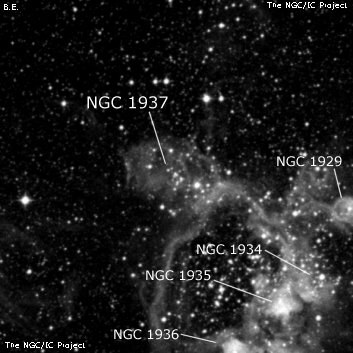
NGC 1936, a very bright nebulous glow, lies 5' S, and other sections of the N44 superbubble complex lie to the southwest including NGC 1929, 1935 and IC 2126. Superimposed on this complex of HII glows is a fairly rich concentration of stars.
John Herschel discovered NGC 1937 = h2845 on 23 Nov 1834 and recorded "vF; pL. An outlier of the group figured in Plate III No. 2. Place from diagram." His detailed sketch (Plate III, figure 2) clearly established that h2845 refers to this nebulous cluster. James Dunlop discovered the entire LH 47 association = D 175 on 27 Sep 1826 and referred to "several seats of attraction". I doubt that NGC 1937 was one of these, though Wolfgang Steinicke credits Dunlop with the discovery.
600/800mm - 24" (4/7/08 - Magellan Observatory, Australia): this object is the furthest northeast in a gorgeous field of stars and HII regions. NGC 1937 is a large nebulous patch, ~3.7'x2.7' in size, with ~20 stars resolved over the bright glow. Excellent contrast gain using a UHC filter at 200x. A string of stars mag 11.5 and fainter oriented WSW-ENE passes through the center of the cluster or star cloud (association LH 48).
Notes by Steve Gottlieb